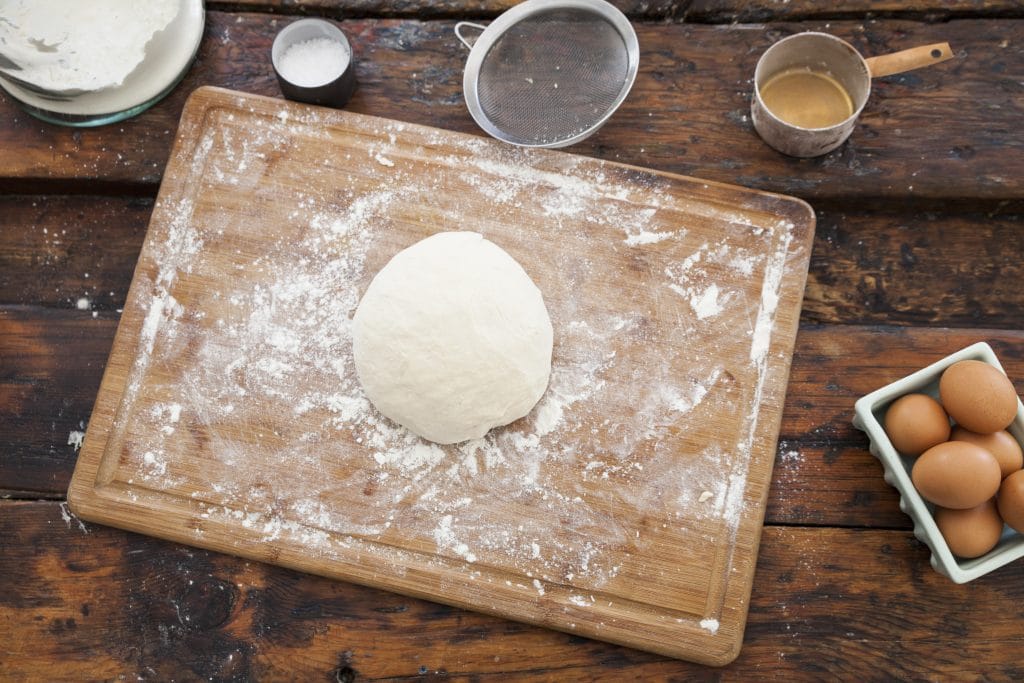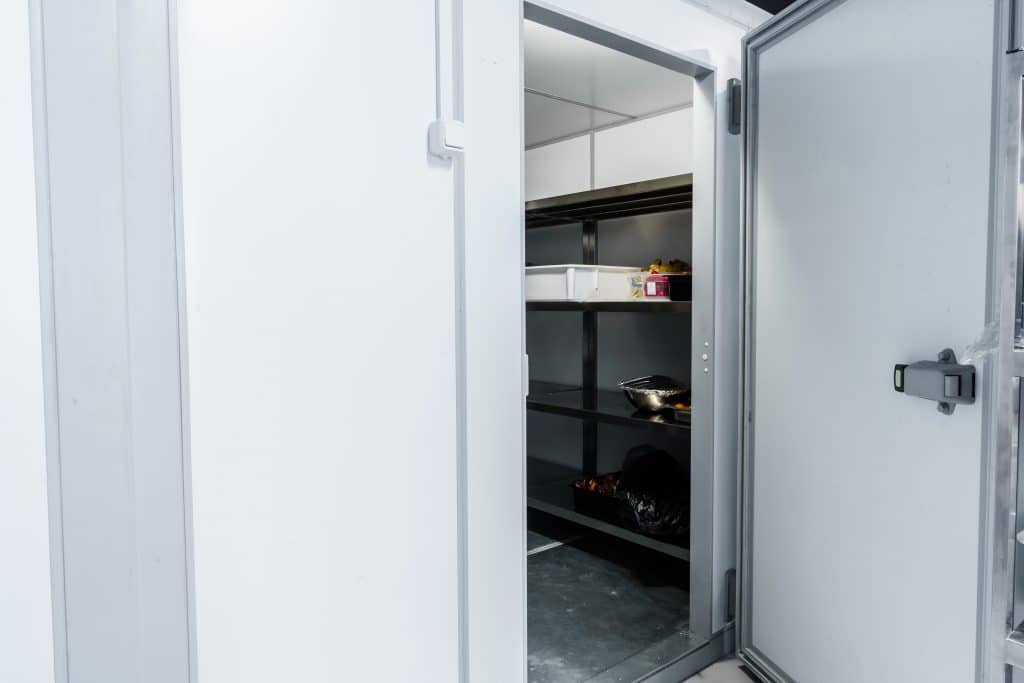How Long Does Dough Last?
Important Note: When you buy through our links, we may earn a commission. As an Amazon Associate we earn from qualifying purchases. Content, pricing, offers and availability are subject to change at any time - more info.
If you’re new to the art of baking, or a curious, experienced baker, you may be wondering about how long you can leave dough before it becomes unsuitable for baking or even goes off. How long does dough last?
How long dough lasts depends on the ingredients and heat of the environment. Yeasted dough lasts four hours at room temperature, five days in the fridge, and three months in the freezer. Don’t leave rich dough at room temperature. Refrigerate it for three days and freeze it for four weeks.
It’s essential to leave bread dough to rise for a while, perhaps even to proof more than once. But how long can you leave dough to prove before it becomes unusable? What about cookie dough? More importantly, how long is it safe to leave dough at room temperature? What about in the fridge? And by how long can you extend the life of dough if you freeze it?

- How Long Does Dough Last At Room Temperature?
- How Long Does Dough Last In the Fridge?
- How Long Does Dough Last In The Freezer?
- Common Questions
How Long Does Dough Last At Room Temperature?
How long dough will last at room temperature depends on the kind of dough you are making.

Let’s look at the different types of dough and how they will influence the length of time they can remain at room temperature.
Yeast Dough
To prove or rise, dough made with yeast needs to be left at room temperature. How long the dough can remain out will depend on the ingredients (especially the amount of yeast), the time needed for the dough to rise, and the room’s temperature.
Plain Dough
If you have made a plain dough with only flour, water, salt, and yeast as ingredients, you can leave the dough out in a cool area for up to 12 hours before it may begin to develop bacteria.
The smaller the amount of yeast you use, the longer you can allow the dough to rise as it will rise more slowly and stand less chance of deflating.
The cooler the room, the slower the yeast will activate as well. Leaving dough out in a warm space will make the yeast rise more quickly, meaning that you can leave the dough in a warm or humid area for a far shorter time.
Whatever the amount of yeast or warmth of the room, leaving dough out for four to six hours will mean that it will overproof. Overproofing means that the dough will collapse in the oven and turn out somewhat dry.
If you leave your plain dough out for longer than planned, you can still use it. It will look very puffy and uneven and may even have collapsed. There may also be a gassy or alcoholic odor from the yeast.
The best use of overproofed plain dough is baking flatbread, like a pizza or focaccia, which doesn’t need much rise.
Rich Dough
Any dough made with dairy ingredients (milk, yogurt, or cream) or eggs is at risk of spoilage far more quickly than plain dough.
Dairy or eggs can quickly develop bacteria at room temperature, making it unsafe to leave an enriched or rich dough out for longer than two hours.
Unfortunately, you should discard it if you have left rich dough out at room temperature, especially in warm or humid conditions.
If you want a long, slow rise for a rich dough, refrigerate it.
Sourdough
Making sourdough bread is a much longer process than ordinary yeasted bread, as the dough requires two fairly lengthy fermentation or rising periods, as well as folding and kneading.
A sourdough starter uses natural yeast found in the environment, so it does not respond like ordinary commercial yeast and takes longer to rise. It needs the warmth of room temperature to develop effectively.
During the first or bulk fermentation, the wild yeasts develop, the dough matures, and the necessary structure for the rising bread grows.
At this stage, sourdough bread takes longer to leaven or rise than ordinary dough: in a warm environment, this rise can take two to four hours. However, if it is cold, the dough can last up to six to eight hours at room temperature before it overproofs or overferments.
Most bakers fold and stretch their sourdough during the bulk rise, so there is less likelihood of it overproofing.
However, if you have overfermented the sourdough, it will turn into a wet and sticky sludge, and it’s best to discard the dough as you cannot salvage it.
After sourdough has had its first rise, the baker will shape it and set it aside for a second rise, usually taking an hour or two at room temperature.
If you leave sourdough for too long for its second rise, it will overproof, but you can still bake it. However, the texture will be affected.
Cookie Dough
Cookie dough contains eggs, milk, cream, or other dairy products, so you cannot leave it out at room temperature without the possibility of spoilage.
Even if you are rolling out and cutting cookies from a piece of dough, wrap the other half in clingfilm and keep it refrigerated until you are ready to use it.
How Long Does Dough Last In the Fridge?
Refrigerating dough means less chance of bacterial contamination, so you can leave most kinds of dough in the fridge for far longer than at room temperature.

Let’s examine the different varieties of dough and how they affect the amount of time they may be kept in the fridge.
Yeast Dough
Yeast dough benefits from being left in the fridge, so many bakers choose to proof their dough in this way. This proofing method is ideal for the first proof, as you can avoid overproofing.
Plain Dough
Yeast dough can safely sit in the fridge for five to seven days, with regular attention.
Refrigerating yeast dough will not stop it from rising: it will rise slowly but will rise nonetheless. If the dough increases to double its size, knock or punch it down and allow it to rise again. When you’re ready to bake, take the dough out and allow it to return to room temperature. Then bake as usual.
There are advantages to refrigerating yeasted dough — it imparts more flavor and texture and slows down the rise, which means you can schedule your baking time when it suits you. Many bakers choose to proof their dough in the fridge for these reasons.
If you leave yeasted dough in the fridge for longer than five days, you risk overproofing the dough as the yeast may lose its effectiveness.
The dough will not rise as well as it should, so perhaps go the pizza or focaccia route.
However, plain dough is unlikely to go bad in the sense of being inedible, so you can always try baking dough that you have forgotten you’ve left in the fridge.
Rich Dough
Because of the ingredients, a rich dough does not do well left in the fridge for too long. Refrigeration keeps the dough fresher than it would at room temperature, but perishable ingredients still go bad after a couple of days.
Ideally, do not keep rich dough refrigerated for more than three to five days, but preferably use it within 48 hours.
The benefits of refrigerating plain dough do not apply here — much of the flavor of richer doughs comes from the ingredients, so you won’t develop the taste and texture.
Again, take care not to allow your dough to overproof as you can’t make pizza from a rich dough.
Sourdough
Bakers disagree on whether proofing sourdough in the fridge benefits flavor and texture. Refrigerating sourdough will retard the natural yeast’s development, so the rising process slows down almost entirely.
Sourdough bakers, therefore, tend to use the fridge as a retarding tool, allowing the proofing process to extend longer than usual for scheduling rather than flavor purposes.
You can leave dough made with a sourdough starter in the fridge for up to 14 hours. It is unlikely that sourdough will overproof in the refrigerator or spoil unless you leave it for days on end.
It is more common for sourdough to be refrigerated during its second rise — bakers often refrigerate the shaped dough in its pan overnight, allow it to reach room temperature as the oven preheats, and bake it immediately.
Cookie Dough
Refrigerating cookie dough has many advantages, not only that it prevents spoilage.
Cookie dough for drop cookies or roll-out cookies benefits from a couple of hours of refrigeration, even leaving it overnight or for up to five days.
The cold temperatures work magic on cookie dough, cooling the ingredients down, allowing the gluten in the flour to relax and absorb moisture, the sugar to start dissolving and being absorbed, and the extracts to develop, which intensifies flavor and texture.
Refrigeration also allows the fats in the dough (usually butter) to solidify, which means you will have a better chance of the cookies rising and setting — warm butter means that the cookies will spread and puddle.
There is no need to bring cookie dough to room temperature — roll or drop and bake.
However, cookie dough will spoil even in the fridge after five days of refrigeration. It may turn grey, begin absorbing odors from surrounding food and lose the ability to rise properly.
How Long Does Dough Last In The Freezer?
Freezing preserves food, dough included. Again, the length of time in the freezer depends on the kind of dough.

Let’s look at the various types of dough and how they affect the amount of time they can be kept in the freezer.
Yeast Dough
Yeasted dough freezes effectively, so long as it has been through its first rise. Freezing does destroy yeast, though, so the second rise will never be as substantial as if the dough were fresh.
To bake frozen dough, allow it to defrost in the fridge overnight, allow it to proof for a second time, and bake.
Plain Dough
A plain yeast dough will last for around three months in the freezer, so long as you freeze it in the correct container and at the right stage of the dough preparation process.
To freeze yeast dough, mix and knead the dough and allow it to rise as expected for the first proofing. Knock down the dough, as usual, shape it, and wrap it for freezing.
To protect dough from freezer burn, you need to wrap it in greased plastic wrap. Place the dough in a loaf tin if you want to shape it in the freezer. Once the dough freezes in shape, place it in an airtight freezer bag. For other dough, roll it into a disc, wrap in greased plastic wrap, and put it in an airtight freezer bag.
Always defrost dough in the refrigerator. Let the dough rise before baking.
Rich Dough
A rich dough will last for only a month in the freezer, although bakers recommend using challah or brioche dough within two to three weeks for best results.
However, frozen rich dough never rises as effectively as fresh dough because of the ingredients.
Prepare the dough for freezing as you would with plain dough.
Sourdough
You can freeze raw sourdough for up to four weeks with little effect on the flavor and texture of the bread.
Unlike other yeasted bread, it is best to freeze sourdough after the second rise so that the wild yeast has had enough time to develop.
After you have shaped your bread and allowed it to rise a second time, freeze the sourdough as per the instructions for plain dough.
Allow the frozen dough to thaw in the refrigerator, proof while the oven preheats, and bake.
Cookie Dough
Homemade cookie dough lasts for up to three months in the freezer, so long as it is a robust buttery dough, not a delicate macaron or madeleine dough.
Just as refrigerating cookie dough improves it, freezing does the same. The great advantage of freezing cookie dough is that you are always about 10 minutes away from fresh cookies!
The method of freezing cookie dough will depend on the kind of cookie you are making.
- For drop cookies (like choc chip, oatmeal raisin, or peanut butter), refrigerate the dough as you would usually for an hour. Roll the cold dough into cookie-size balls and stash it in airtight freezer bags. You can bake these cookies from frozen, adding a couple of minutes to the baking time.
- For roll-out cookie dough (like spice or gingerbread cookies), roll the dough into a disc. Wrap the dough tightly in plastic wrap. Freeze in an airtight freezer bag. Thaw the dough before rolling, cutting, and baking as usual.
- Roll the cookie dough into logs, wrap, and freeze airtight for freeze-and-bake cookies. To use, allow the dough to soften slightly in the refrigerator before slicing and baking.
Common Questions
It is generally not safe to leave dough with milk left out at room temperature overnight. This is because milk can spoil quickly, especially at warm temperatures, and when combined with dough, it can create a breeding ground for harmful bacteria. It is best to store dough with milk in the refrigerator until you are ready to use them, a common step in making brioche. If you do accidentally leave the dough and milk out overnight, it is best to throw it away and start with fresh ingredients to be safe.
How long you can leave dough at room temperature, in the fridge, or in the freezer depends on the dough and the ingredients. In general, plain yeasted dough or sourdough can be left at room temperature for up to four hours, in the fridge for a few days, and in the freezer for three months. Avoid leaving any rich dough containing eggs or dairy products at room temperature as it may spoil.
To store dough in the refrigerator, first make sure that the dough is well-covered. You can place the dough in a bowl and cover it with plastic wrap or a damp cloth. Alternatively, you can place the dough in an airtight container or zip-top bag. Before storing the dough, make sure to press out any excess air to prevent the dough from drying out. Once the dough is well-covered, place it in the refrigerator. Be sure to store the dough in the coldest part of the refrigerator, away from any sources of heat or moisture. This will help the dough retain its texture and flavor and prevent it from spoiling.
























